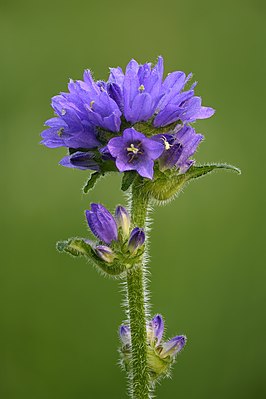Bristly bellflower
| Bristly bellflower | ||||||||||||
|---|---|---|---|---|---|---|---|---|---|---|---|---|

Bristly bellflower |
||||||||||||
| Systematics | ||||||||||||
|
||||||||||||
| Scientific name | ||||||||||||
| Campanula cervicaria | ||||||||||||
| L. |
The bristle bellflower ( Campanula cervicaria ) is a species of the bellflower family (Campanulaceae).
features
The bristle bellflower is a biennial to perennial plant and reaches heights of 40 to 80 cm. It forms thick, deep roots . The spreading of the basal leaves as well as the leaves in the lower stem area have an elongated-lanceolate leaf shape , they are widest in the middle and narrow into the winged petiole. The leaves and the stem are hairy, stiff and bristly. The upper stem leaves are eilanzettlich and sessile.
The inflorescence consists of a head-like, terminal clusters of flowers and, lower down, further, but few-flowered partial inflorescences. The flowers are light blue, 12 to 20 mm long and have a funnel to bell shape. They are seated and hairy on the outside. The sepals are less than half as long as the corolla tube, narrowly ovate, blunt and hairy. The bays between the calyx tips are also blunt and have no appendages. The stylus mostly protrudes from the crown. Flowering time is June and July, pollination is mainly done by bees ( melittophilia ). The fruit is a multi-seeded capsule , stands upright, is hairy and opens near the lower end with three pores.
The number of chromosomes is 2n = 34.
Distribution and locations
The area of the bristle bellflower extends from Central Europe to Western Siberia. In Germany it is considered critically endangered. In Austria it is rare, classified as endangered and only occurs in Burgenland, Lower Austria, Styria and Carinthia. In Switzerland it occurs almost only in the Central Plateau and is considered to be endangered nationwide.
The bristle bellflower grows in damp meadows, on fringes and in light forests. It occurs mainly on fresh, rather chalky soils of the colline to montane altitude range . It occurs in societies of the associations Molinion, Geranion sanguinei, Carpinion or the order Quercetalia pubescentis.
supporting documents
- Siegmund Seybold (Ed.): Schmeil-Fitschen interactive . CD-ROM, version 1.1. Quelle & Meyer, Wiebelsheim 2002, ISBN 3-494-01327-6 .
Individual evidence
- ↑ a b Erich Oberdorfer : Plant-sociological excursion flora for Germany and neighboring areas . With the collaboration of Angelika Schwabe and Theo Müller. 8th, heavily revised and expanded edition. Eugen Ulmer, Stuttgart (Hohenheim) 2001, ISBN 3-8001-3131-5 , pp. 892 .
- ↑ Bristly bellflower. In: FloraWeb.de. , accessed August 29, 2008.
- ^ Manfred A. Fischer, Karl Oswald, Wolfgang Adler: Excursion flora for Austria, Liechtenstein and South Tyrol . 3rd, improved edition. State of Upper Austria, Biology Center of the Upper Austrian State Museums, Linz 2008, ISBN 978-3-85474-187-9 .
- ↑ Campanula cervicaria. In: Info Flora (The National Data and Information Center for Swiss Flora) , accessed July 29, 2008.
Web links
- Bristly bellflower. In: FloraWeb.de.
- Bristly bellflower . In: BiolFlor, the database of biological-ecological characteristics of the flora of Germany.
- Profile and distribution map for Bavaria . In: Botanical Information Hub of Bavaria .
- Campanula cervicaria L. In: Info Flora , the national data and information center for Swiss flora . Retrieved April 5, 2016.
- Distribution in the northern hemisphere from: Eric Hultén, Magnus Fries: Atlas of North European vascular plants. 1986, ISBN 3-87429-263-0 at Den virtuella floran. (swed.)
- Thomas Meyer: Bellflower data sheet with identification key and photos at Flora-de: Flora von Deutschland (old name of the website: Flowers in Swabia )


